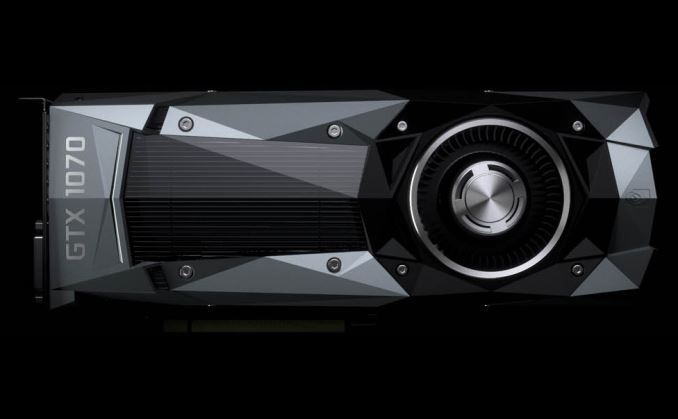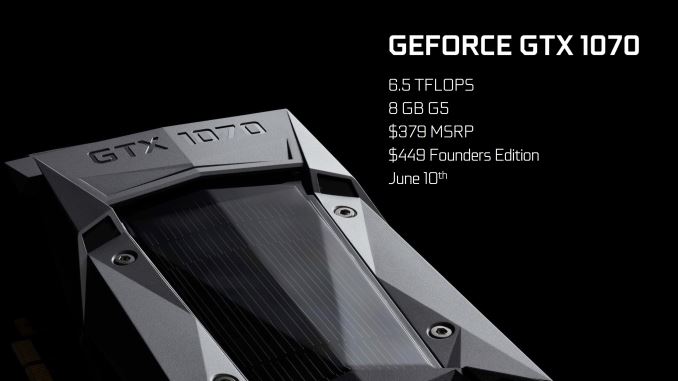NVIDIA Posts Full GeForce GTX 1070 Specifications: 1920 CUDA Cores Boosting to 1.68GHz
by Ryan Smith on May 18, 2016 10:15 PM EST
Back when NVIDIA first announced the GeForce GTX 1080 earlier this month, they also briefly announced that the GTX 1070 would be following it. The GTX 1070 would follow the GTX 1080 by two weeks, and presumably to keep attention focused on the GTX 1080 at first, NVIDIA did not initially reveal the full specifications for the card. Now with the GTX 1080 performance embargo behind them – though cards don’t go on sale for another week and a half – NVIDIA has posted the full GTX 1070 specifications over on GeForce.com.
| NVIDIA GPU Specification Comparison | ||||||
| GTX 1080 | GTX 1070 | GTX 970 | GTX 770 | |||
| CUDA Cores | 2560 | 1920 | 1664 | 1536 | ||
| Texture Units | 160 | 120 | 104 | 128 | ||
| ROPs | 64 | 64 | 56 | 32 | ||
| Core Clock | 1607MHz | 1506MHz | 1050MHz | 1046MHz | ||
| Boost Clock | 1733MHz | 1683MHz | 1178MHz | 1085MHz | ||
| TFLOPs (FMA) | 8.9 TFLOPs | 6.5 TFLOPs | 3.9 TFLOPs | 3.3 TFLOPs | ||
| Memory Clock | 10Gbps GDDR5X | 8Gbps GDDR5 | 7Gbps GDDR5 | 7Gbps GDDR5 | ||
| Memory Bus Width | 256-bit | 256-bit | 256-bit | 256-bit | ||
| VRAM | 8GB | 8GB | 4GB | 2GB | ||
| FP64 | 1/32 | 1/32 | 1/32 | 1/24 | ||
| TDP | 180W | 150W | 145W | 230W | ||
| GPU | GP104 | GP104 | GM204 | GK104 | ||
| Transistor Count | 7.2B | 7.2B | 5.2B | 3.5B | ||
| Manufacturing Process | TSMC 16nm | TSMC 16nm | TSMC 28nm | TSMC 28nm | ||
| Launch Date | 05/27/2016 | 06/10/2016 | 09/18/14 | 05/30/13 | ||
| Launch Price | MSRP: $599 Founders $699 |
MSRP: $379 Founders $449 |
$329 | $399 | ||
Previously disclosed at 6.5 TFLOPs of compute performance, we now know how NVIDIA is getting there. 15 of 20 SMs will be enabled on this part, representing 1920 CUDA cores. Clockspeeds are also slightly lower than GTX 1080, coming in at 1506MHz for the base clock and 1683MHz for the boost clock. Overall this puts GTX 1070’s rated shader/texture/geometry performance at 73% that of GTX 1080’s, and is a bit wider of a gap than it was for the comparable GTX 900 series cards.
However on the memory and ROP side of matters, the two cards will be much closer. The GTX 1070 is not shipping with any ROPs or memory controller channels disabled – GTX 970 style or otherwise – and as a result it retains GP104’s full 64 ROP backend. Overall memory bandwidth is 20% lower, however, as the GDDR5X of GTX 1080 has been replaced with standard GDDR5. Interestingly though, NVIDIA is using 8Gbps GDDR5 here, a first for any video card. This does keep the gap lower than it otherwise would have been had they used more common memory speeds (e.g. 7Gbps) so it will be interesting to see how well 8Gbps GDDR5 can keep up with the cut-down GTX 1070. 64 ROPs may find it hard to be fed, but there will also be less pressure being put on the memory subsystem by the SMs.
Meanwhile as is usually the case for x70 cards, GTX 1070 will have a lower power draw than its fully enabled sibling, with a shipping TDP of 150W. Notably, the difference between the GTX 1080 and GTX 1070 is larger than it was for the 900 series – where it was 20W – so we’re going to have to see if GTX 1070 ends up being TDP limited more often than GTX 1080 is. In that sense TDP is somewhat arbitrary – its purpose is to set a maximum power consumption for cooling and power delivery purposes – and I’m not surprised that NVIDIA wants to stay at 150W or less for the x70 series after the success that was the GTX 970.
Like the GTX 1080, the GTX 1070 will be launching in two configurations. The base configuration is starts at $379 and will feature (semi) custom partner designs. Meanwhile as previously disclosed, NVIDIA will be offering a Founders Edition version of this card as well. The Founders Edition card will be priced at $449 – a $70 premium – and will be available on day one, whereas this is not guaranteed to be the case for custom cards.
The GTX 1070 Founders Edition card will retain the basic stylings of the GTX 1080, including NVIDIA’s new angular shroud. However I have received confirmation that as this is a lower TDP card, it will not get the GTX 1080’s vapor chamber cooler. Instead it will use an integrated heatpipe cooler similar to what the reference GTX 980 used.











137 Comments
View All Comments
metayoshi - Thursday, May 19, 2016 - link
Hardware numbers are one thing, but what really matters is overall gaming performance with these cards. With the 970, one could get roughly 85-90% of the 980's performance in games for 60% of the 980's cost. Here, we don't have performance numbers yet in actual games, but the 1070 is ~63% of the 1080 price. If the performance somehow proves to be still in the high 80 percent range of a full 1080, I'd say the 1070 is still worth it, but it's still too early to call.TallestJon96 - Thursday, May 19, 2016 - link
Yes, or coarse we should wait for benches. Everyone will be different as to what is worth it or not. To some, 980 was worth the money, to me its not. For some spending even $330 on "just graphics" is not worth it, but to me it is. I'm right on the fence between the 1080 and 1070 right nowbartendalot - Thursday, May 19, 2016 - link
Someone let the kids have access to their parents computer and they found this comments section.I know there is a fandom for both of the graphics card companies, but these comments don't make AMD look good - unless they are trying to get more angst-ridden 12 year-olds to join their cause.
xthetenth - Friday, May 20, 2016 - link
Do you actually buy your graphics cards based on smug condescension towards comment sections? We all know people are bad at choosing metrics that turn dollars into frames but this one takes the cake.kaesden - Thursday, May 19, 2016 - link
I wonder how long until we find out it only has 7gb full-speed memory :PAcarney - Thursday, May 19, 2016 - link
I haven't bought a video card in like ten years (been a MacBook user) but I'm aiming for a HTPC/Console replacement now. Can you underclock these cards without major bios hacking or anything? I know they've made simple over clocking settings but no one talks about underclocking (which I totally understand). The goal for me is bringing the TDP closer to 100 - 120w. I know I'll trade some performance but this would be connected to a 1080p plasma so I don't need 4K performance. What I do need is lower TDP to fit into a fanless enclosure... Yet I would like to keep the 256bit memory bandwidth and full card. The next step down will probably be a pretty cut down card and maybe only 4gb of ram and 192-128bit memory :-/Mugur - Friday, May 20, 2016 - link
Maybe you should get a Nano... Or wait for the inevitable miniITX version for the 1070 (970 had some).TheinsanegamerN - Friday, May 20, 2016 - link
Yes you can underclock with things like afterburner, but if you are pushing a 1080p display, you really dont need a 1080, or even a 1070. For a HTPC/console, something like the 1060 (when it comes out) would be a better idea.bill44 - Thursday, May 19, 2016 - link
Nothing about audio?Does it support 88.2khz, 176.4khz,192khz?
Decode DTS-HD, Atmos? Just an example.
Dorek - Thursday, June 2, 2016 - link
>Does it support 88.2khz, 176.4khz,192khz?Does it matter? None of those have any advantage over 44.1kHz audio.